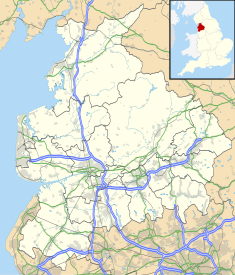Stubbylee Hall
| Stubbylee Hall | |
|---|---|
 The building in 2010 | |
| Location | Stubbylee Lane, Bacup |
| Coordinates | 53°41′34″N 2°12′12″W / 53.6928°N 2.2032°W |
| Built | 1808 |
| Architectural style(s) | Neoclassical style |
Listed Building – Grade II | |
| Official name | Stubbylee Hall |
| Designated | 18 June 1968 |
| Reference no. | 1163375 |
Stubbylee Hall, formerly known as Bacup Town Hall, is a former municipal building in Stubbylee Lane in Bacup, a town in Lancashire in England. The building, which served as the offices and meeting place of Bacup Borough Council, is a Grade II listed building.[1]
History
[edit]The building was commissioned as a private house by the Holt family, in the early 19th century. The senior member of the family at that time was James Holt, a local baize manufacturer.[2] It was designed in the neoclassical style built in ashlar stone and was completed in 1808.[3][4] It was enlarged in 1872, under the ownership of the member of parliament, James Maden Holt.[1]
Following significant population growth, largely associated with textile manufacturing, a local board of health was established in Bacup in 1863.[5] The area was then incorporated as a municipal borough in 1882.[6] The borough council initially established a council chamber and an office for the town clerk in the market hall on the corner of Bank Street and Lord Street.[7]
In 1914, Stubbylee Hall was purchased by Bacup Borough Council, using money donated by Miles Ashworth. Ashworth was the first President of the Rochdale Equitable Pioneers Society.[8] In accordance with Ashworth's wishes, the grounds of the hall were laid out as a public park, and the house was converted for municipal purposes. The town hall continued to serve as the headquarters of the borough council for much of the 20th century,[9] and remained the meeting place for the enlarged Rossendale Borough Council which was formed in 1974.[10][11][12]
In the early 2000s, the council moved to Hardman's Mill in Rawtenstall, and the hall was left vacant.[13] A stag's head which for many years had been on display in the hall was recovered from storage and returned to its original place on the staircase in 2006.[14] In August 2018, Valley Heritage was contracted to identify potential future uses for the building.[15]
Architecture
[edit]The two-storey hall is built of sandstone, with a slate roof. It is in the neoclassical style, and has a symmetrical five-bay front, with the outermost bays slightly projecting as curved wings. The centre bay is also slightly projected forward, and features a porch formed by Ionic order pilasters supporting an entablature and a balcony. The centre bay incorporates a French door on the first floor, while the curved wings are fenestrated by sash windows. Inside, there is a stone staircase under a moulded plaster ceiling, with a domed skylight incorporating stained glass. Early furnishings in the building include cupboards and built-in bookcases. The building was grade II listed in 1968.[1]
See also
[edit]References
[edit]- ^ a b c Historic England. "Stubbylee Hall (1163375)". National Heritage List for England. Retrieved 1 March 2024.
- ^ Baines, Edward; Parson, William (1825). History, Directory, and Gazetteer, of the County Palatine of Lancaster. Vol. 2. W. Wales and Company. p. 639.
- ^ "Stubbylee Hall" (PDF). Bacup Times. Retrieved 1 March 2024.
- ^ "Stubbylee Hall". Holt Ancestry. Retrieved 1 March 2024.
- ^ Greater Manchester Gazetteer, Greater Manchester County Record Office, Places names – B, archived from the original on 18 July 2011, retrieved 20 June 2007
- ^ Rossendale Borough Council, A Brief History of Rossendale; Bacup, Government of the United Kingdom, p. 2, archived from the original on 18 March 2014, retrieved 3 September 2013
- ^ Newbigging, Thomas (1893). "History of the Forest of Rossendale". Simpkin, Marshall & Company. p. 230.
- ^ "The Rochdale Pioneers' Graves - A self-guided trail" (PDF). Rochdale Metropolitan Borough Council. p. 8. Retrieved 1 March 2024.
- ^ "No. 46186". The London Gazette. 18 January 1974. p. 795.
- ^ Local Government Act 1972. 1972 c.70. The Stationery Office Ltd. 1997. ISBN 0-10-547072-4.
- ^ "National Lottery success for Stubbylee Hall". Heritage Trust Network. 12 April 2019. Retrieved 1 March 2024.
- ^ "Pride and passion over old town hall sell-off Date=30 June 1997". Lancashire Telegraph. Retrieved 1 March 2024.
- ^ "Mill approved for council meetings". Lancashire Telegraph. 8 August 2006. Retrieved 1 March 2024.
- ^ "Missing 'trophy' back on display". Rossendale Free Press. 4 August 2006. Retrieved 1 March 2024.
- ^ "New hope for the long-term future of historic Stubbylee Hall in Bacup". Lancashire Telegraph. 27 August 2018. Retrieved 1 March 2024.

